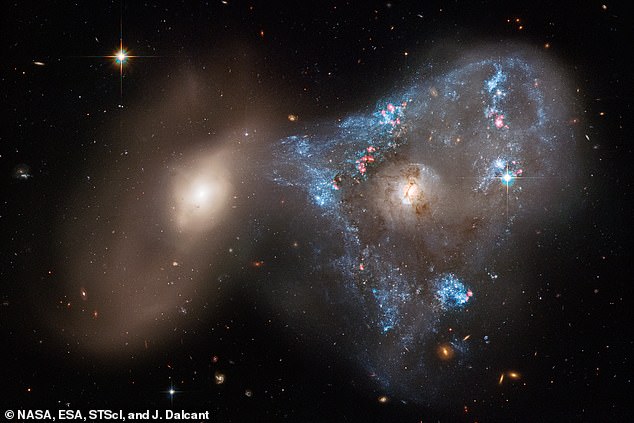NASA’s Hubble Space Telescope has captured a stunning image of a “space triangle” where two galaxies collide, resulting in a star-birth tsunami.
The duo known as Arp 143 consists of the bright and distorted star-forming galaxy NGC 2445 and the faint star-forming galaxy NGC 24444.
NGC 2445 has been distorted, appearing triangular in shape, with a wave of bright lights as stars are forming at high speed from material shaken by the collision.
US-based astronomers from the Center for Computational Astrophysics at the Flatiron Institute in New York and the University of Washington in Seattle analyzed images captured by a 32-year-old observatory in low Earth orbit.
They explained that the galaxies passed through each other, igniting a firestorm in a unique way, while thousands of stars came to life.
The galaxy is drenched in stars because it is rich in star-producing gas and fuel, but it has not yet escaped the pull of its companion NGC 2444, preparing it for a cosmic war, which NGC 2444 appears to be winning.
NASA’s Hubble Space Telescope has captured a stunning image of the “space triangle” where two galaxies collide, triggering a star-birth tsunami.
The dancing galaxies were found in a catalog compiled by astronomer Halton Arp in 1966, consisting of 338 interacting eccentric galaxies.
These strange galaxies were thought to be excellent laboratories for studying the physical processes that distort naturally occurring spiral and elliptical galaxies.
He was one of the first to suggest that galactic encounters could form stars in the form of explosions.
One of the Arp galaxies exploding with new stars is Arp 143, captured in these new images from the Hubble Space Telescope.
“The simulations show that direct collisions between two galaxies are a way to form rings of new stars,” said astronomer Julian Dalcanton.
Therefore, star-forming rings are not rare. However, the strange thing about this system is that it is a star forming triangle.
Part of the reason for this shape is that these galaxies are still very close to each other and that NGC 2444 is still gravitationally bound to the other galaxy.
NGC 2444 may also contain a halo of invisible hot gas that could help draw NGC 2445 gas from its core. Therefore, they have not completely abandoned each other and their unusual interaction distorts the ring in this triangle.
NGC 2445 has been distorted, appearing triangular in shape, with a wave of bright lights as stars are forming at high speed from material shaken by the collision. Wide field width found for the Arp region 143
The weakening of the two galaxies is also responsible for ripping “parasite-like filaments of gas” from their partner, feeding the stream of young blue stars that seem to form a bridge between the two galaxies.
These rivers are among the first in what appears to be a wave of star formation that began on the fringes of NGC 2445 and continued inland when the two collided.
The team behind the study estimates that the streamers were born between 50 and 100 million years ago, and were left in the Triangulum region, where NGC 2445 continues to slowly retreat from NGC 2444.
According to the team, stars no older than 1 to 2 million years old are forming near the center of NGC 2445.
Hubble is so sharp that it is capable of resolving some individual stars within the image, even though most of the bright blue clusters are star clusters. Pink dots are giant young star clusters still covered in dust and gas.
Although most of the events occur in NGC 2445, this does not mean that the other half of the interacting pair survived unharmed. NGC 2444’s gravitational pull twisted into a strange shape.
The galaxy contains old stars and not a new one because it lost its gas a long time ago, long before this galactic encounter.
This is a close example of the types of interactions that took place long ago. “It’s a wonderful sandbox for understanding star formation and the interaction of galaxies,” said Elena Sabi of the Space Telescope Science Institute in Baltimore, Maryland.

“Beer enthusiast. Subtly charming alcohol junkie. Wannabe internet buff. Typical pop culture lover.”

:quality(85)/cloudfront-us-east-1.images.arcpublishing.com/infobae/UDDOK5CJV5CU5MITSI5TNVFIJM.jpg)
:quality(85)/cloudfront-us-east-1.images.arcpublishing.com/infobae/TRFQARYQ25CLHC3YC4ZCI65UFQ.jpg)

:quality(85)/cloudfront-us-east-1.images.arcpublishing.com/infobae/V6ZZZ4HWOVDYZLZBWADR5TFGK4.png)


More Stories
Adobe has a new Photoshop tool with AI to remove people from photos
BlueImage is a new technology from Vivo designed to address common problems in mobile photography
Is it possible to set a password for chats on Instagram? We're telling you